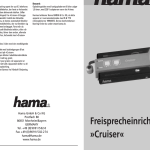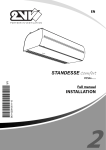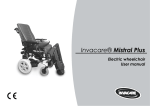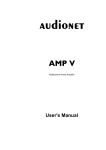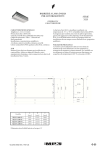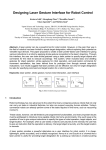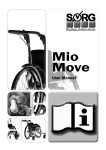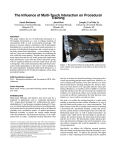Download Product Design - Stovetop - rc
Transcript
Making Stovetop Cooking Accessible to Every Individual San Jose State University DSID 226: Ergonomics for Design Spring 2004 Mike Cheung Aimee Richardson David Ladowitz Allen Wilson Jeff Mellor Brian Wong Robert Murphy Jeannie Yang Stövennoöven Table of Contents Introduction ..................................................................................................................................... 2 Target Consumer Profile ................................................................................................................ 5 Target User Profile.......................................................................................................................... 6 Design Objectives........................................................................................................................... 7 Marketing Requirements ................................................................................................................ 9 Literature Review.......................................................................................................................... 13 Reach ..................................................................................................................................... 13 Work Height ........................................................................................................................... 14 Controls .................................................................................................................................. 15 Control and Burner Association ............................................................................................. 18 Stovetop Dimension (Arc) ...................................................................................................... 20 Handheld Water Dispenser .................................................................................................... 21 General Wheelchair Access................................................................................................... 22 Qualitative Product Performance Requirements .......................................................................... 23 Design Development .................................................................................................................... 26 Controls .................................................................................................................................. 26 Drainage and Spill Control ..................................................................................................... 29 Handheld Water Dispenser .................................................................................................... 30 Usability Tests .............................................................................................................................. 31 Experiment 1: Burner Control (#1) ......................................................................................... 31 Experiment 2: Burner Control (#2) ......................................................................................... 36 Experiment 3: Handheld Water Disperser ............................................................................. 41 Experiment 4: Stove Design .................................................................................................. 45 Discussion .............................................................................................................................. 52 Conclusion ............................................................................................................................. 54 Product Functionality .................................................................................................................... 55 Product Specifications .................................................................................................................. 59 Conclusion .................................................................................................................................... 60 References ................................................................................................................................... 61 Appendix A: Experiment 1 & 2 Survey ......................................................................................... 64 Appendix B: Experiment 3 Survey................................................................................................ 65 Appendix C: Experiment 4 Survey................................................................................................ 66 Appendix D: Experiment 4 Pictures.............................................................................................. 67 Appendix E: Experiment 4 User Comments................................................................................. 69 Appendix F: Final Mockup Pictures .............................................................................................. 70 1 Stövennoöven Introduction Stovetop cooking is a task common to most people, from young adults to the elderly, people of varying heights, and people of varying physical abilities. Frequency of use of a stovetop can vary from occasionally, once or twice a week, to several times a day. There exists, a challenge to redesign the commonly used stovetop, in such a way to accommodate the variety of users as mentioned. Goal Our goal is to design a stovetop that is easy to use and accessible to the majority of the population, including the population restricted to a wheelchair, while maintaining esthetic considerations. The Problem Most stoves are either an integrated oven and stove appliance, or a counter-top installed stove (see Figure 1). This results in a fixed height workspace with no leg room for wheelchair access, nor toe space for standing access (allows one to stand closer to workspace). This can be an inconvenience or even cause discomfort for users of extreme heights or those restricted to a wheelchair. The standard stove has a quadratic burner configuration with front and back rows of burners (see Figure 2). The reach required for the rear burners (19-20 in.) is just beyond the approximate reach distance for a male, and is considerably beyond the approximate reach distance for a female (Konz, 2000). Not only can this reach distance cause discomfort, it may require reaching over a hot element, potentially causing harm. 2 Stövennoöven This quadratic burner configuration is usually accompanied by a linear configuration of controls. It is not always obvious which control activates which burner, requiring one to recall which control they need to access, or refer to a diagram of the control to burner association. Water is a common ingredient in stovetop cooking, yet sinks are not usually located within close proximity to a stove. This requires one to carry pots of water to a stove, or worse, carry pots of hot water to a sink. Access to and cooking on a traditional stove from a wheelchair can be cumbersome and dangerous. One method is to position the side of the wheelchair in front of the stove, and twist the body to see and reach the stovetop (Don, SJSU student , personal communication, April 21, 2004). Another method is to position the front of the wheelchair in front of the stove, and slide the body to the front edge of the wheelchair seat. This allows easier access, but is unstable and has resulted in falls (personal communication, March 2004). Water access is also difficult; those confined to a wheelchair can only carry a limited amount of water at a time, requiring multiple trips from a sink to the stove (Don, April 21, 2004). Figure 1. Figure 2. 3 Stövennoöven The Solution Considerations in the re-design of a stovetop will include height of equipment, reach required, safety issues and cognitive requirements in the use of the equipment. An adjustable height stovetop, with one row of four burners will be presented. To optimize reach and accessibility for both standing and wheelchair users, we will introduce and test an arced cutaway, in the front of the stove, to position the elements of the stovetop around. A centrally located sink will be included, to increase both ease of access to, and disposal of water. Controls for the burners will have a direct proximal relation to the respective burner, with combined temperature and timer functionality. Displays of functionality and usage will be integrated in both the burner elements and the controls. 4 Stövennoöven Target Consumer Profile Age 23 – 60 yrs of age Gender Male & Females National Origin Worldwide Language and Culture All Physical Impairments Physically able and mobility impaired (wheelchair) consumers. Mental Impairments All Frequency of Use The targeted consumer can cook everyday, or not at all. Motivation The targeted consumer is attracted to an esthetically and ergonomically designed stove. Income Bracket The product is targeted at consumers in the 100K+ household income bracket. However, for those with mobility impairment, we expect healthcare insurances to subsidize the cost of the stove, and thus, expect the consumer to be in the 50K+ household income bracket. Other Home owner 5 Stövennoöven Target User Profile Age 12 – 90+ yrs of age. Gender Male & Females Height Stature: 152.78 cm (5th Percentile Female) – 186.65 (95th Percentile Male) Elbow: 92.63 cm (5th Percentile Female) – 115.28 cm (95th Percentile Male) Knee (sitting): 47.40 cm (5th Percentile Female) – 60.57 cm (95th Percentile Male) Reach Distance Average Reach 15 in. National Origin Worldwide Language and Culture The product has been designed with universal cultural considerations. While its’ first release will be in English, the design is intended to transcend language/cultural barriers. Reading Skills The product has been designed to be intuitive, and thus require limited reading ability. Physical Impairments The product is designed for the physically able and mobility impaired (wheelchair). The product is not designed to be used by those visually impaired or arm manipulation impaired. Mental Impairments The product has been designed to maximize safety, though accidents may still happen. Thus, the product is not meant to be used by those with extensive mental impairments. Motivation The user is motivated by comfort and safety in cooking. 6 Stövennoöven Design Objectives The following are a list of design objectives for the Stövennoöven stovetop. 1) Safety a. The burners arrangement should reduce reach over a hot surface. b. The burners should not heat or stay on unless a pot or pan is detected over it. 2) Comfort a. The stovetop should accommodate the optimize work height of the user population. b. The shape of the stovetop should accommodate the natural reach distances of the user population. c. The stovetop should accommodate the wheelchair and legs of a handicapped user. 3) Efficiency a. The burners should not take more energy than the average stovetop to operate. b. The burners should heat to desired temperature within 30 seconds. c. The burners height adjustment mechanism should not take too much energy, make too much noise, or take to long to operate. 4) Ease of Use a. The temperature/timer control should be easily associated to the correct burner. b. The temperature/timer control lettering should be easily legible. c. The temperature and timer components of the control should be easily identified/differentiated. d. The handheld sprayer should pull easily to the desired location, and retract automatically when released. e. The handheld sprayer controls and display should be easily legible. 7 Stövennoöven 5) Productivity a. The temperature/timer control should require little time to learn. b. The handheld sprayer controls should require little time to learn. c. The stovetop design should be intuitive and minimize human errors. 6) Reliability a. The handheld sprayer’s water measuring mechanism should be accurate up to .05 of a cup. b. The timer should keep accurate time to .001 seconds. c. The burner should always heat up to the same temperature associated with the level of heat indicated on the temperature/timer control. 7) Durability a. The stove surface should be able to hold up to 300 lbs. b. The stove should stand up to knocks, bumps, and aggressive cleaning. 8) Aesthetics/Novelty a. The stove should be pleasing to the eye. b. The stove should perk curiosity. c. The stove should easily match various kitchen décor. 8 Stövennoöven Marketing Requirements Document (MRD) Scope This is the Marketing Requirements Document for Stovennooven. It comprises requirements for the entire first release, including service warranty plans and marketing collaterals. The purpose of Stovennooven will be to make cooking universally available to every individual. Product Release Strategy Current market conditions are good for Stovennooven. The nature of features in the Stovennooven design makes it unique to the large appliances market. Stovennooven will be released first in May 2005. It will first be distributed throughout the US and Canada by retail channels (i.e. Sears, Home Depot, Expo). Stovennooven will be released worldwide the following year, May 2006. At the time of the US and international release, the following will need to be completed: • Stovennooven (see Functional Requirements) • Packaging for Stovennooven for shipping and handling. • Manual (in English, French, Spanish, German, Italian, Chinese, Japanese) • Service warranty plans. • Marketing Collaterals 9 Stövennoöven Functional Requirements Priorities of requirement: • Priority 1 -- absolutely must be in release. • Priority 2 -- Highly desirable, should consider removing from release only if it would delay the scheduled release. • Priority 3 -- Desirable for this release, should include if time and resources permit. 1. Height Adjustment Priority: 1 The motorized height adjustment must be operational and under 40 decibels when in operation. 2. Burner Priority: 2 The burner should heat/cool to desired temperature within 30 seconds. 3. Burner Safety Mechanisms Priority: 1 The burner should not turn on unless there is a pot/pan on it. Once on, the burner will turn red and stay red until the burner is room temperature. 4. Temperature/Timer Control Priority: 1 The temperature/timer control should be fully functional. The temperature should control the burner temperature. The timer should time the duration of the burner on low/medium/high, and turn the burner off when the time runs to zero. 10 Stövennoöven 5. Handheld Sprayer Priority: 1 The sprayer must dispense and measure (in cups) water. The sprayer should pull out easy, and self retract when the user releases grip. 6. Sink Priority: 1 The sink must be to design specifications, and should collect and drain discarded water. 7. Sink Accessories Priority: 2 Attachable sink accessories (i.e. strainer) should be to design specifications, and should snap on and off the sink. Other Requirements 1. User Documentation (Manual) Requirements Priority: 1 The user documentation should include the stove’s functional instructions as well as instructions on an ergonomic install. The documentation will be required at least 2 months before it goes to print. QA and end users must proof the documentation before it goes to press. 2. Internationalization Requirements Priority: 1 Stovennooven will be released first in the US and Canada, then in Europe and Asia. Thus, Stovennooven’s interface, manual, and marketing collaterals must be developed for fast translation. 11 Stövennoöven 3. Packaging Priority: 1 Stovennooven should be packaged by 4 ply cardboard and Styrofoam. The packaging should withstand freight shipping, and rough handling. 4. Extended Warranty Plans Priority: 3 Extended warranties plans should be evaluated and priced for 2, 5, and 10 year options. Offers for extended warranty should be included in the User Manual. 5. Marketing Collateral Priority: 1 Marketing brochures and datasheets should be colorful, clean, and uncluttered. The collaterals will be required 2 months before print for review and approval. The collaterals must be printed and distributed to retail channels in time for product release dates. 12 Stövennoöven Literature Review Reach A common guide to follow for reach requirements is to allow the shorter person to reach, and allow the larger person to fit (Konz & Johnson, 2000). To accommodate this guideline we will consider the 5th percentile female reach distance, which is approximately 15 in. (35 cm) (Konz & Johnson, 2000). This distance is within the dimensions of the preferred manipulation space as defined by Kroemer, Kroemer and Kroemer-Ebert (2001), and within the normal work area as defined by Barnes (see Figure 3). Figure 3. Area of normal work area, as proposed by Barnes. McCormick (1970). 13 Stövennoöven Work Height Providing proper work height is a key element in ergonomic design. Work surfaces too high can result in excessive shoulder abduction, or raising at the elbows. The worker must have their arms up at a high angle to manipulate objects or simply work on the high surface. Work surfaces too low can force the worker to bend forward at the torso, stressing the lumbar or lower back, and may cause the worker excessive neck flexion, or bending the neck forward, to see or reach the surface. The optimal work height to avoid situations described here, should be 5 cm (2 in.) below the elbow (Konz & Johnson, 2000). Considering the elbow height measurements from the 5th percentile female, and 95th percentile male, the work surface heights to accommodate are from about 87 cm (34 in.) to 110 cm (43 in.) (Konz & Johnson, 2000). Because workstations are usually installed at a fixed height, 90 cm (35.5 in.) is recommended to accommodate most of the population (Konz & Johnson, 2000; Grandjean, 1973). Work height injuries as described here, are no stranger to the kitchen. A study by Pekkarinen and Anttonen (1988), surveyed 200 kitchen workers, analyzing worker’s stature, work surface height, and reported injuries of the workers. Of the respondents, 75% reported shoulder symptoms, 58% reported neck symptoms, and 50% reported lumbar symptoms. When evaluating work surface heights, consideration must be taken in regards to the tasks, object manipulation, and object height. This certainly applies to a stovetop, where each of these factors can vary, depending on what one is cooking, and the size of the cooking container. 14 Stövennoöven Additional anthropometric factors to consider are the age of the population, and the population restricted to wheelchairs. People actually decrease in stature as they age beyond 40 to 50 years (Kroemer et al., 2001). The disabled population, restricted to wheelchairs, have yet another set of requirements. Work surface heights for wheelchair access are from 71–86 cm (28-34 in.), with recommend stove top heights 76–86 cm (3034 in.). Wheelchair access also requires 69 cm (27 in.) knee space (Peterson, 1998). To best accommodate the variety of population and tasks, Konz & Johnson, (2000) recommends three solutions, (a) change the height of the work surface, (b) change the height of the worker, or (c) change the height of the object being manipulated. Option (b) and (c) we have no control over, but we do have control of the height of the work surface, the stove top. That is why we will provide an adjustable height stove, as recommended by Grandjean (1973) and Pekkarinen and Antonen (1988). Controls Advantages to using touch input The advantages to using touch input displays are well documented ranging from practical to technical reasons. Touch displays can be molded to make them easy to clean and very appealing for dirty environments or environments required stringent cleanliness such as hospitals or kitchens (Lee, Buxton, & Smith, 1985). The control surface of the touch input is overlaid on the display and no extra space or input mechanism is required for the interactions (Albinsson & Zhai, 2003). Finally, when using a finger touch display, there is no physical stylus to get lost, broken or vibrate out of position (Lee et al., 1985). 15 Stövennoöven Touch displays are also advantageous in offering a better user experience than other input paradigms. Albinsson and Zhai (2003) found that touch screens or input displays are particularly appealing to novice users because there is zero displacement (time-lag) between input and output, control and feedback as well as hand action and eye gaze. They are also more robust than other input mechanisms, especially in demanding environments. Potter, Weldon, and Shneiderman (1988) reported that touch screens enable quick learning and rapid performance, do not consume extra workspace, have no moving parts and evoke high user satisfaction. For the reasons of simplicity, ease of use and durability makes a touch screen an attractive choice for both designers and human factors specialists to implement in a kitchen. Using a touch screen furthers the goals of both groups. Layout and size of targets There are a number of design and interaction techniques to consider when implementing a touch display. The layout of the screen must be clear and organized and the size of buttons must accommodate the range of human finger width. The buttons must be able to sense finger pressure appropriately, offer force feedback and display feedback in a comfortable and accurate manner. The tactile feedback provided to the user is also critical because the sense of touch is such an important human sensory channel (Hinkley & Sinclair, 1999). Hall, Cunningham, Roache, and Cox, (1988) found that increasing the size of the input targets for touch displays reduced the number of errors and increased the speed of input. An optimal target size is 36 mm on the x-axis and 32 mm on the y-axis to maintain an accuracy of 99.5% for a screen size of 13 inches. For smaller displays, this does not scale by ratio and in general a target should not be smaller than 30 mm x 30 mm. 16 Stövennoöven Albinsson and Zhai (2003) have also found that the human finger as a pointing device has a low resolution and it is difficult to point at or press targets that are smaller than the finger width, therefore an input target must accommodate the 95th percentile male finger width. Tactile feedback Tactile feedback from the surface to the fingers also facilitates ease of use and high user satisfaction ratings as a mode of input. Poupyrev, Maruyama, and Rekimoto (2002) found a 22% faster completion rate when their handheld touch interface provided tactile feedback. He also notes that surfaces distinguished by roughness or differences in textures can be accurately detected by touch and when developing a tactile interface, it should not be forgotten that the surface should “feel good.” Petrie, Morley and Weber (1995) report that tactile information gives a spatial representation of the world and detailed knowledge is provided at the fingertips. Tactile information is processed faster than visual stimuli. Humans can distinguish between two consecutive tactile stimuli in about 5 ms which is about 5 times faster than the vision sense (Poupyrev et al., 2002). Tactile feedback provides information to blind users who would otherwise not have access and an additional mode of feedback for sighted users. Force feedback Nashel and Razzaque (2003) found that using physical buttons were better than virtual buttons because of the force feedback (a.k.a. tactile feedback) delivered to the user after pressing the button. The user knows when they have pushed hard enough to active the button. The push pressure is delivered to the device via a vibration and devices should process a wide vibration frequency bandwidth because of the variability in amount of pressure applied by different users, ideally between 1 and 1000 Hz (Poupyrev et al., 17 Stövennoöven 2002). Other strategies have also been employed to ensure accurate input from human touch such as a dampening effect to filter out minor pressure fluctuations (Herot, 1977) and a take-off strategy (Potter, et al., 1988) to signal when input has ended. Auditory beeps can also be used as a way to signal activation/deactivation, but tactile feedback is preferred (Lee, et al. 1985). There should be no lag from the user perspective between input and output. A touch strategy that provides continuous feedback until a selection is confirmed results in fewer errors than other touch strategies (Potter, et al., 1988). A touch sensitive device must be able to sense continuous pressure as well as accept at least two levels of pressure (Buxton, 1985). The ability to sense simultaneous points of contact, accept input and provide output is also an important feature to facilitate ease of use when implementing touch displays (Lee, et al., 1985). Control access from a wheelchair For ease of access from a wheelchair, controls should be located near the front of the stove. Touch pad controls, to avoid grasping or twisting, and a visual display of function, are recommended (Peterson 1998; Davies & Beasley 1999). Control and Burner Association Proper control and burner arrangement is important to facilitate ease of use by minimizing thought processing in accessing controls, and to maintain safety by minimizing the chance of accidentally activating the incorrect burner, potentially causing harm or damage. Konz & Johnson (2000) recommends consistent grouping to differentiate between controls, and sufficient clearance to avoid accidentally accessing the wrong control. 18 Stövennoöven Kroemer et al. (2001) recommends a control and display (burner in this situation) be close to each other, either directly below or to the right. They should be arranged so a user can locate and identify the correct control easily, with minimal effort. Several studies of control and burner arrangements have been conducted with three main goals: to determine user stereotypes, rate errors using various arrangements, and analyze variability of products on the market. A stovetop layout with a linear arrangement of controls in front of a quadratic arrangement of burners was used for most of these studies. Shinar (1978), conducted a survey to determine a population stereotype of control and burner arrangements, and also reported availability of various control and burner arrangements on the market. Four main arrangements were identified from the survey, but the only significant result was a left and right side association, where the two left controls activated the two left burners, and the two right controls activated the two right burners. The most commonly available arrangement found in the market research, differed from the four identified in the survey results, and even violated the right and left side association preferred above. Ray and Ray (1979) tested user errors and preferences on the four control and burner arrangements identified by Shinar (1978). Among the four, one was preferred more often than the others for both tests, but the results were not statistically significant. Smith (1981) conducted a survey covering a variety of display, control and label relationships, including control and burner arrangements, in attempt to identify population stereotypes or preferences. In this test, the same four arrangements as in earlier tests emerged, but out of the four, a different arrangement was most preferred. 19 Stövennoöven Hsu and Peng (1993) conducted similar studies, but to avoid suggestive sequencing, controls and burners were labeled with symbols, instead of numbers or alphabetical characters. They found yet another preferred arrangement, again part of the original four discussed earlier. Further analysis identified cultural differences between American and Chinese users, having preferences for different control and burner arrangements. Probably the most significant and relevant results were by Chapanis and Lindenbaum (1959), whose experiment was a bases or model for some of these more recent studies. Their tests included linear arrangements of both controls and burners, and found no errors in these arrangements. With an identified cultural difference in control/burner arrangement preferences, no clear population preference or stereotype, and errors with variations on the linear to quadratic layout, a linear to linear, or a one to one control and burner relationship is probably the best solution. Stovetop Dimension (Arc) Factors considered for the arc dimension are the right and left arm work area curves, anthropometric dimensions of the torso, and wheelchair maneuverability. Curvatures of the normal work area, as defined by Barnes, are created by the movement abilities of the right and left arm (see Figure 1) (McCormick, 1970). The widest breadth of the torso, taken from the 95th percentile female, is 17 in. (43.2 cm) (Konz & Johnson, 2000). The deepest depth of the torso, taken from the 95th percentile male, is 10 in. (26 cm) (Wickens, Gordon & Lui, 1997). The turning radius required for a wheelchair is 60 in., but up to 19 in. can be accommodated by allowing knee or leg space. This results in a turning radius from 41 - 60 in. (Peterson, 1998). 20 Stövennoöven Handheld Water Dispenser Most handheld tool grip dimensions are given in relation to force required with the tool. Our handheld will require minimum force, so a range to follow is 30 – 50 cm in diameter, or 10 cm less than the users inside grip diameter, with a minimum length of 125 mm (Konz & Johnson, 2000). A non-circular cross section is recommended to maintain tactile orientation and decrease slippage (Konz & Johnson, 2000). A varying or form fitting shape along the length is also recommended to decrease slippage and account for various lengths of fingers (Konz & Johnson, 2000). Also, a design narrower on the ends, instead of straight, is suggested (see Figure 4) (Kroemer et al., 2001). A smooth compressible surface to reduce slippage is recommended (Konz & Johnson, 2000). The handheld device should be designed so normal use will allow the hand to remain in a neutral position, with no bending the wrist (see Figure 5) (Konz & Johnson, 2000; Kroemer et al., 2001). Figure 4. (Kroemer et al., 2001) Figure 5. Neutral position of hand. National Institute of Environmental Health Sciences (2001) 21 Stövennoöven General Wheelchair Access Additional stovetop recommendations for wheelchair access are, a smooth cooking surface to facilitate transfer of pots on and off heated surfaces, a minimum edge surface to aid in safe transport of pots on and off the stovetop, and burner arrangements that will not require reaching over one burner to access another (Peterson, 1998; Davies & Beasley, 1999). It is also recommended to have a sink with a pull out faucet located near the stove, for ease of access and disposal of water (Peterson, 1998). 22 Stövennoöven Quantitative Product Performance Requirements From reviewing literature and studies of stove and kitchen designs, anthropometric data of the population, design needs of the population restricted to wheelchairs, and drawing upon personal experiences and evaluations, the following product requirements have been developed to meet our design objectives. General • All functionality of the stove will be viewable and within reach from a standing or seated position • All functionality of the stove will accommodate ambidextrous access Height • Height of the stove will be adjustable • Range of heights to accommodate: • • Minimum knee space: 68.5 cm (27 in.) • Minimum working height: 76 cm (30 in.) • Maximum: 110.28 cm (43.25 in.) Height will be adjustable via a switch located on the front of the stove Safety • • A power off switch will be located on the front of the stove • Ability to turn all power off in case of emergency • Maintain power off state to avoid accidental activation of burners All wires and heating elements (underside of stove) will be enclosed behind insulated material • The underside of the stove will be a smooth non-abrasive finish 23 Stövennoöven Stovetop Surface • The stovetop will have a smooth surface • The surface will be a scratch and impact resistant material • The surface will be a dark color • There will be a raised edge around the stovetop to maintain spills • The front 4 in. of stovetop will be angled Sink • The sink will be large enough to pour water from a cooking pot into • Sink will be mounted below stovetop surface, allowing easy clean-up: liquids can be wiped directly into sink • There will be a 1 in. lip around the rim of the sink, to deter splashes • Plumbing will be flexible, to accommodate height adjustments Handheld Water Dispenser • Grip • 30-50 cm diameter • Minimum length 125 cm • Oval cross section • Form fitting shape – narrower at the ends • Hand position during usage: straight or normal • Surface will be smooth and compressible • Extendable faucet and hose will reach all burners • Dispenser will accommodate measurements of water in the following increments (cups): 1/4, 1/3, 1/2, 2/3, 3/4, 1 cup, continuous flow Stovetop Dimension (Arc) • Curve width: 36 in. (body width of 17 in. + 4.5 in. moving space on either side) • Curve depth: 15 in. ( (body depth of 10 in. / 2) + 5 in. moving space in front) • Curve angle to match connected curves of normal work area (figure 1). • Curve to fit between a 60 in. and 41 in. radius circles 24 Stövennoöven Controls • The controls will have visual indicators of functionality, use, and status • Each control will have an integrated timer, controlling the burner it’s responsible for • The controls will be a minimum size of 30 x 30 mm • The controls will be mounted on an angled surface on the front edge of the stovetop arc Burners • There will be four circular burners, in one row, two on each side of the sink • Three burners will be maximum 9 in. in diameter, one burner will be maximum 12 in. in diameter • Design of each burner will indicate positions for 3 in., 6 in., 9 in., and 12 in. diameter heating elements • Burners will be positioned with the center point no further than 15 in. from the front edge of the stove • The position of the burners will follow the same curvature as the arc of the stovetop • Each burner will have its own control, located directly in front of the respective burner in the angled surface of the stovetop • Burners will visually indicate when they are hot, and will continue to do so after the control is set to off, until the heat has dissipated • Burner heating element will only be activated when a pot is on the respective burner • Burner heating elements will sense the size of the pot and only activate one of the three indicated dimensions, in relation to the pot size 25 Stövennoöven Design Development Controls Goals 1) Design easy to use interface(s) to control burner temperature and timer 2) Minimize interaction, provide efficiency of operation 3) Provide appropriate feedback of current status and settings Solution 1 • Smooth surface electric touch pad control • Separate timer and temperature controls • Digital countdown display • Buttons: • Timer Start, Stop, Clear • Hour and Minute increment / decrement • LED message indicating status and next step required • Circular temperature control Problems Encountered • Timer control: inefficient use of space, too horizontal Solution 2 • Timer interface more square, more space efficient design • Clock function added Problems Encountered • Lacking in objective concinnity with rest of stove (round burners, arced front) • Lacking familiarity with stereotypical stove control • Too many steps to function 26 Stövennoöven Solution 3 • Incorporate timer into center of temperature control • Reduce potential confusion with timer/burner association • Remove clock function • Reduce number of steps for functionality Problems Encountered • Inefficient use of space • Arrow buttons too small • Start / Stop / Clear buttons confusing Solution 4 • Move digital display to top of available space • Enlarge timer buttons • Consider color scheme to indicate temperature settings Problems Encountered • Still looked confusing, too many elements and variety of shapes Solution 5 • Introduce color gradient within circular arc to indicate temperature setting • Reduce number of temperature setting buttons • Added text indicators to heat levels • Timer buttons configured into circular design • Digital display moved to center of control • Design Tested Problems Encountered • Not obvious to users outer ring were buttons • “Timer on” button was not used • Plus and Minus increment / decrement buttons not used consistently 27 Stövennoöven Solution 6 • Outer ring of buttons shaded grey • Space added between outer ring of buttons • Changed “Timer On” to “Timer Start/Stop” • Changed “hr” to “hour” • Changed + / - increment buttons to arrow up and arrow down buttons • Design tested Problems Encountered • Users still had confusion of whether to use or how to use “Timer Start/Stop” button Solution 7 • Remove “Timer Start/Stop” button • not needed, will start automatically after three seconds of setting • Final Version 28 Stövennoöven Drainage / Spill control Goals 1) Integrate into stovetop, the ability to maintain potential spills 2) Solution should allow for easy clean-up of spills 3) Solution should be not interfere with visual esthetics and functionality of stove Options Considered 1) Four tube drainage system • Current use – weather drainage of large amounts of water • Concept – use the same idea to drain grease, oil, and fat from cooking into another area 2) “George Foreman Grill” Teflon coated surface • Current use – non-stick cooking and easy clean up • Concept – use for easy clean up and a drainage system 3) Gutter • Current use – use for diverting rain to localized areas • Concept – modify the gutter, so that grease would flow into localized section(s) with containers for storage and/or dumping Solution • Simple ½ in. raised lip along edge of stovetop • Keep spills from flowing off surface • Spills can be wiped directly into below-surface sink • Visually and physically integrated into stovetop design • No additional equipment to maintain • Keep costs to a minimum 29 Stövennoöven Handheld Water Dispenser Goals 1) Design easy to use interface and handheld control with ability to set, indicate and dispense varying quantities of water. 2) Minimize interaction, provide efficiency of operation 3) Provide appropriate feedback of current status and settings Design Progression 1) Sketched forms, ideas from similar existing designs 2) Physical foam mockup created 3) Added screen printout and updated button configuration 4) Updated screen interface 5) Water dispenser button “water drop”, glossy to distinguish from handle 6) Slightly longer handle, so water dispenser further away from hand 7) Water measurement buttons will include “cup” diagram, to clarify function 8) Rubber grip handle 9) Highlights of hardware in chrome 30 Stövennoöven Usability Tests Introduction A series of four usability tests were performed: two on the burner/control touch display, one on the handheld water dispenser, and one on the overall stovetop layout. The purpose for the iterative testing procedure was to collect feedback during the design process from our target audience and integrate the feedback into the features and functionality to further design improvement. The goal of the user-centered design testing was to match the needs of the audience to the design and tailor the design to meet those needs. Experiment 1: Burner Control Touch Display A color paper prototype of the burner control display was tested to ensure users could identify the correct input targets based on the task at hand. Common tasks for this display are setting the burner to the desired temperature and selecting the cooking time duration. There is a one-to-one relationship between each burner and control touch display. The prototype was not completely functional meaning feedback such as selection indicator lights or digital numbers did not appear during task execution. None of the tasks required this feedback in order to complete successfully; however, variations in behavior did provide valuable insight as to the feedback users expected from the display. Changes were made to the burner control based on task completion success, survey feedback and general comments made by users after each test session. Behavioral observations made by testing team members also influenced design revisions. 31 Stövennoöven Method Participants Eight participants, 4 males and 4 females participated in this test. The participants ranged in age from 21 to 50 years old. Four were graduate students, two were undergraduate students and two were not students. Two were political science majors, two were library science majors, one was a computer engineering major and one was a computer science major. Three participants cooked at least 7 times per week, three cooked at least 3 times per week and two did not cook at all. Two pilot studies were conducted prior to initiating this testing session, but the data from these participants is not included in the demographics above or the data analysis. Participants were recruited in the San Jose State University Martin Luther King Library and tested in one of the conference rooms. Apparatus A color paper prototype of the burner control display was printed and presented to all test participants (see Experiment Figure 1). Experiment Figure 1 - Paper prototype of burner control display 32 Stövennoöven Procedure Each participant was given a set of instructions before beginning the tasks. The participant was asked to indicate when they were finished with the task by saying, “done.” Task completion times were recorded with a stop watch to the nearest tenth of a second. Task success rates were also recorded. Success was regarded as indicating all appropriate input targets for the task at hand. Task failure was regarded as indicating an incorrect input target during any portion of the task or saying they had completed the task when they actually had not. Tasks were representative of common tasks a person would likely do all the time. The instructions given to each participant before beginning the tasks are as follows: (a) take 1 minute to get familiar with the control design. The control is an integrated temperature/timer control for an electric stove, (b) you will be asked 5 task oriented questions to execute on this control. Please respond as quickly and accurately as possible. Please say “done” when you have finished the task, (c) this is a continuous test. Assume that the status of the controls carry over the last task. The tasks to be completed by each participant were as follows: (a) set the stove on high, (b) turn the heat down to low, (c) turn the stove off, (d) set the stove on high for 2 hours and 15 minutes, and (e) turn the timer off, while leaving the stove on high. Task completion times and task success rates were recorded. The survey given to each participant was on a 1 -7 scale, asking them to rate attributes. The scale was reversed for certain questions, where the most favorable score corresponded with the smallest number, in order to ensure the participant read the question carefully. The survey questions asked were as follows: (a) how easy was it for 33 Stövennoöven you to familiarize yourself with this control design, (b) rate the attractiveness of your stove control at home, (c) rate the attractiveness of this control design, (d) rate the ease of use for your stove/timer control at home, (e) rate the ease of use of this control design, (f) was the functionality of the buttons on this control design well defined, and (g) overall, would you prefer your stove controls or this stove control design? (Appendix A) Changes were made to the current design based on the data analysis of task completion time, task success rates, survey feedback, and observations of user expectations. Results The Mean task completion times (seconds) for the first burner control touch display test were as follows: task 1 (M = 6.77, SD = 6.6), task 2 (M = 3.98, SD = 4.29), task 3 (M = 2.12, SD, 1.11), task 4 (M = 17.55, SD = 9.23), and task 5 (M = 6.24, SD = 2.48) (see Experiment Figure 2). The successful task completion rates for each task were: task 1 = 87.5%, task 2 = 87.5%, task 3 = 100%, task 4 = 25%, and task 5 = 87.5%. Participants had the most difficulty with task 4 which was to set the timer for a specific period of time. The Mean completion time was the highest compared to other tasks and the success rate was 25%. Based on the feedback comments by participants, users were confused at to how to turn the timer on, start the timer and input the time amount. 34 Stövennoöven Task Completion Time (seconds) Burner Control Touch Display Test 1 20 15 Mean Completion Time (seconds) 10 5 0 Task 1 Task 2 Task 3 Task 4 Task 5 Experiment Figure 2. Task Results for Burner Control Test 1. The Mean values for the survey questions for the burner control touch display test are as follows: Easy to familiarize (M = 5.25, SD = 1.28), attractiveness of home stove control (M = 3.5, SD = 1.51), attractiveness of tested stove control (M = 5.38, SD = 1.3), ease of use of home stove control (M = 5.25, SD = 1.39), ease of use of tested stove control (M = 4.5, SD = 1.85), clarity of button functionality (M = 5.38, SD = .92), and preference of tested stove control vs. home control (M = 4.5, SD = 2), favoring our design over users’ home design (see Experiment Figure 3). Experiment Figure 3. Survey Results for Burner Control Test 1. 35 Preference of Test vs. Home Clarity of Functionality Ease of Use Test Ease of Use Home Attractiveness of Test Attractiveness of Home Easy to familiarize 7 6 5 4 3 2 1 0 Stövennoöven Experiment 2: Burner Control Touch Display (#2) Method Participants Ten participants, 5 males and 5 females participated in this test. The participants ranged in age from 21 to 38 years old. Two were graduate students, seven were undergraduates and one was a teacher. Two were industrial design majors; one was a corporate finance major, one an electrical engineering major, one business management, one child development major, one computer science major, one industrial engineering major and one was an MBA student. Two participants cooked at least 7 times per week, three cooked 5 times per week, three cooked 2-3 times per week and two did not cook at all. Participants were recruited in the San Jose State University Student Union Building and tested in the same building. Apparatus A revised color paper prototype of the burner control display was printed and presented to all test participants (see Experiment Figure 4). The following changes were made to this prototype (a) increased space between outer ring of buttons and made outer ring of buttons grey- to look more like "touchable" buttons and (b) changed timer increment from plus/minus signs to arrow up/arrow down. 36 Stövennoöven Experiment Figure 4 – Revised paper prototype of burner control display Procedure The same procedure was used for test 2 as was used for test 1. Results The Mean task completion times (seconds) for the second burner control touch display test were as follows: task 1 (M = 5.68, SD = 8.7), task 2 (M = 2.41, SD = 1.71), task 3 (M = 1.1, SD = .36), task 4 (M = 12.03, SD = 4.49), and task 5 (M = 5.66, SD = 2.6) (see Experiment Figure 5). The successful task completion rates for each task were: task 1 = 100%, task 2 = 100%, task 3 = 100%, task 4 = 0%, and task 5 = 80%. Participants continued to have difficulty with task 4 which was to set the timer for a specific period of time. The Mean completion time was the highest compared to other tasks and the success rate was 0%. Based on the feedback comments by participants, users were confused at to how to turn the timer on and how to stop the timer. They were confusing the button “stop” which was to turn the stove off with the button “clear” 37 Stövennoöven intended for turning the timer off. Users did however, have more success with the time setting portion of the task due to interface changes that were made for this iteration of testing. Task Completion Time (seconds) Burner Control Touch Display Test 2 14 12 10 8 Mean Completion Time (seconds) 6 4 2 0 Task 1 Task 2 Task 3 Task 4 Task 5 Experiment Figure 5. Task Results for Burner Control Test 2. The Mean values for the survey questions for the second burner control touch display test are as follows: easy to familiarize (M = 5.6, SD = 1.35), attractiveness of home stove control (M = 5.2, SD = 1.99), attractiveness of tested stove control (M = 5.5, SD = 1.58), ease of use of home stove control (M = 5.4, SD = 1.26), ease of use of tested stove control (M = 5.1, SD = 1.52), clarity of button functionality (M = 6.1, SD = 1.37), and preference of tested stove control vs. home control (M = 4, SD = 2.6), favoring our design over users’ home design (see Experiment Figure 6). 38 Stövennoöven Preference of Test vs. Home Clarity of Functionality Ease of Use Test Ease of Use Home Attractiveness of Test Attractiveness of Home Easy to familiarize 7 6 5 4 3 2 1 0 Experiment Figure 6. Survey Results for Burner Control Test 2 For each task, completion times decreased and the survey results indicated that the revisions to the burner control touch display made it easier to familiarize, more attractive, easier to use, and the clarity of the functionality improved (see Experiment Figures 7 and 8). The preference of the tested design over the home design remained close to the same value, but this could be due to the fact that the participants in the second test group rated the attractiveness of their home design much higher than the first groups of participants. 39 Stövennoöven Comparison of Task Completion Time - Test 1 and 2 Task Completion Time (seconds) 20 15 Test 1 10 Test 2 5 0 Task 1 Task 2 Task 3 Task 4 Task 5 Experiment Figure 7. Task Results Comparison for Burner Control Test 1 and Test 2. 7 6 5 4 Test 1 3 Test 2 2 1 e .H vs es t Pr e fe re n ce of T of F ity la r C om al ity io n un ct se Te st e U of e Ea s Ea s e of U ss se of H om Te om en e ct iv ti v ac At tr a en e ss of H ilia fa m to y At tr Ea s st e r iz e 0 Experiment Figure 8. Survey Results Comparison for Burner Control Test 1 and Test 2. 40 Stövennoöven Experiment 3: Handheld Water Dispenser and Display A sturdy foam core mockup of the dispenser handle with a plastic overlay of the water measuring display embedded into the front view of the handle was tested to ensure the shape of the handle offered a comfortable grip and that users could successfully accomplish common tasks such as setting and dispensing the desired amount of water to release. Physical buttons were also included on the handle for setting/changing and releasing the water amount. The prototype was static and did not provide feedback when an action was made. However, based on behavior observations it was clear the user was aware that feedback would be present in a fully functional design. Task completion times, task success, survey feedback, behavior observations and general comments were collected, analyzed and used to guide further development. Method Participants The same participants as the Burner Control Display – Test 2 participated in this test and match those demographics. Apparatus A foam core mockup in the shape of a dispenser handle with water measuring display on the front and non-functional physical buttons was presented to each participant (see Experiment Figures 9 and 10). 41 Stövennoöven Experiment Figure 9 - Dispenser Handle – Front View Experiment Figure 10 – Dispenser Handle – Back View Procedure The instructions given to each participant before beginning the tasks are as follows: (a) take 1 minute to familiarize yourself with this handheld. This handheld is a sprayer for a sink/faucet, (b) you will be asked three questions to execute. Please respond as quickly and accurately as possible. Please say “done” when you have finished the task, (c) this is a continuous test. Assume that the status of the handheld carry over from the last test. 42 Stövennoöven The tasks to be completed by each participant were as follows: (a) please dispense free flowing water, (b) please set the handheld to dispense 3 cups of water, and (c) please change the setting to 2 cups of water and dispense the water. Task completion times and task success rates were recorded. The survey given to each participant was on a 1 -7 scale, asking them to rate attributes. The scale was reversed for certain questions, where the most favorable score corresponded with the smallest number, in order to ensure the participant read the question carefully. The survey questions asked were as follows: (a) how would you rate the feel of the handheld’s grip and (b) how easy was it for you to familiarize yourself with the handheld’s interface? (see Appendix B) Changes were made to the current design based on the data analysis of task completion time, task success rates, survey feedback, and observations of user expectations. Results The Mean task completion times (seconds) for the water dispenser handle display test were as follows: task 1 (M = 3.68, SD = 1.5), task 2 (M = 6.42, SD = 1.71), and task 3 (M = 4.55, SD = 2.75) (see Experiment Figure 11). The successful task completion rates for each task were: task 1 = 30%, task 2 = 70%, and task 3 = 90%. 43 Stövennoöven Task Completion Time (seconds) Handheld Water Dispenser Handle and Display 7 6 5 4 3 2 1 0 Task 1 Task 2 Task 3 Experiment Figure 11. Task Results for Water Dispenser Handheld Display 7 6 5 4 3 2 1 Comfort of grip Ease to familiarize with interface Experiment Figure 12. Survey Results for Water Dispenser Handheld Display All participants completed the tasks quickly and without hesitation. They were most successful at setting the water display to the desired amount and dispensing the water. The initial task of dispensing water posed some difficulty because the button located on the back of the handle was not immediately intuitive. This is not an insurmountable problem and the button is easily discoverable. The survey results indicate that the participants were comfortable with the grip and found the interface easy to use (see Experiment Figure 12). 44 Stövennoöven Experiment 4: Stove Design Layout A mockup of the stove design representing the workstation dimensions expected in a completed design was tested to ensure that the physical workspace coincided with the variation of human anthropometry. The mockup was composed of black cardboard, with the stove arc cut from the front and the surface featured paper stove burners with the control displays placed in the corresponding positions. The stove surface was held into place with the grips attached to metal bars and was height adjustable. Also, a space for the sink was reserved in the center of the arc and the water dispenser was above it. The water dispenser was extendable to reach each burner as well as retract to the resting position. (See Appendix D for Photographs of Experiment 4, and Appendix E for user comments from Experiment 4.) The primary purpose for this test was to observe the physical movements of the user while doing common tasks such as stirring contents atop a burner and moving a pot from one burner to another. Arm and torso abductions were observed and a Rapid UpperLimb Assessment (RULA) was done to analyze the safety of the design and the likelihood that injuries could occur over long-term use. Method Participants Ten participants, 5 males and 5 females, participated in the test. Two participants were left-handed and 8 were right handed. The percentiles of standing elbow height, measured from the floor, ranged from 18th percentile to 98th percentile male and 44th percentile to 100th percentile female. The percentiles of sitting thigh width, measured from above the seat, ranged from 1st percentile to 46th percentile male and 1st percentile 45 Stövennoöven to 36th percentile female. One participant used a wheelchair 100% of the time and nine participants used a wheelchair none of the time to complete their daily activities. The anthropometric data for standing elbow height was not collected from the wheelchair using participant and the measurement collected sitting thigh width was below the smallest percentile. Permission was obtained from each participant to videotape them during the testing procedure. Participants were recruited using Yahoo! Groups registered to San Jose State University and from the San Jose State University Art Building. The test took place in one of the rooms inside the Art building. Apparatus A full-scale mockup with all four burners and control displays, a place for the sink and a hanging foam core water dispenser was presented to each participant. Procedure For the stove design layout test, participants were given a set of instructions and told they would complete a set of tasks in both the wheelchair and standing positions. The tasks were representative of common tasks users would complete in everyday activities using the stove. They were video taped at three different angles: front-left, front-right and back-left. All verbal comments were also recorded during the session. After all tasks had been completed, a survey was given to each participant to rate different aspects of the design and ease of use attributes. Measurements were taken for each participant, of their standing elbow height from the floor and their sitting thigh height from above the seat. Percentiles were calculated for each participant and the stove height was adjusted to inches below the participant’s 46 Stövennoöven standing elbow height. A $5 gift card incentive was given to each participant after completing the session. The nine participants who were not regular wheelchair users were asked to get familiar with the wheelchair in which they would be seated during the sitting portion of task completion. The one participant, who did use a wheelchair full-time, had his own wheelchair and did not need the familiarization portion of the test session. The stove height for the standing tasks was set to 6 inches below the standing elbow height (2 inches for proper working height and 4 inches for height of cooking pot). For the seated tasks, the stove height was set at a recommended height of 27 inches above the floor, to accommodate the wheelchair height, or if the participant’s seated thigh height was above the wheelchair arm rest, then it was adjusted so the legs could clear underneath the stove. The instructions given to each participant before beginning the tasks are as follows: (a) you will be presented with a life size mockup of a stovetop. The stovetop is meant to be adjustable in height, and it will be adjusted to the most optimal height for your stature, (b) you will be asked 7 task oriented questions to execute, (c) this is a continuous test. Assume that each task flows into the next, and (d) this test will be repeated standing and sitting. The tasks to be completed by each participant were as follows: (a) make yourself comfortable in front of the stove and familiarize yourself with the wheelchair (if sitting), (b) remove the pot from the far left burner, (c) place the pot on the far right burner, (d) set the far right burner on high, (e) fill the pot with water by pulling the handheld toward the pot, (f) stir the contents of the pot, and (g) dump the contents of the pot into the sink. 47 Stövennoöven The sitting and standing order of task completion was counterbalanced across participants. Still images from the video tapes were used to measure each participant’s angles and abductions of the limbs and neck for each task. Results were analyzed and assigned a level using the Rapid Upper Limb Assessment (RULA) methodology (Konz, 2000), which will assess the likelihood of repetitive stress injuries occurring over long-term use. The RULA methodology assigns a score to each area of the body based on the deviation from the recommended position. The scores are then added to obtain a grand score. The grand score corresponds to a level of action. Scores between 1 and 2 are level 1: posture is acceptable if not maintained or repeated for long periods; scores between 3 and 4 are level 2: further investigation is needed and changes may be required; scores between 5 and 6 are level 3: investigation and changes are required soon; and a score of 7 or higher is level 4: investigation and changes are required immediately. The survey given to each participant was on a 1 -7 scale, asking them to rate attributes. The scale was reversed for certain questions, where the most favorable score corresponded with the smallest number, in order to ensure the participant read the question carefully. The survey questions asked were as follows: (a) how comfortable was the height of the stove while standing (b) how comfortable was the height of the stove while sitting, (c) would you change the height of the stove in the standing position, if so, by how much, (d) would you change the height of the stove in the sitting position, if so, by how much, (e) how comfortable were you with the curve of the stove while standing, (f) how comfortable were you with the curve of the stove while sitting, (g) how convenient was the burner location, and (h) overall, how do you feel about the current stove arrangement compared to your stove arrangement at home? (Appendix C) 48 Stövennoöven Results The RULA scores for each task completed by each participant for both the wheelchair and standing trials were calculated (see Experiment Figure 13). For task 1 standing (pick up pot from left burner), 3 participants were within the acceptable range and 6 were listed as level 1: posture is acceptable if not maintained or repeated for long periods. For task 1 wheelchair, 2 participants were within the acceptable range, 6 were listed at level 1, and one participant was listed at level 2: further investigation is needed and changes may be required. For task 2 standing (place pot on far right burner), 3 participants were within the acceptable range and 6 were listed at level 1. For task 2 wheelchair, none were within the acceptable range, 6 were listed at level 1 and 4 participants were listed at level 2. For task 3 standing (turn far right burner on), 3 participants were within the acceptable range and 6 were listed at level 1. For task 3 wheelchair, 3 participants were within the acceptable range and 7 were listed at level 1. For task 4a standing (grab handheld), 2 participants were within the acceptable range and 7 were listed at level 1. For task 4a wheelchair, none were within the acceptable range, 9 were listed at level 1 and one participant was listed at level 2. For task 4b standing (pull handheld to pot), 3 participants were within the acceptable range, 5 were listed at level 1 and one participant was listed at level 2. For task 4b wheelchair, none of the participants were within the acceptable range, 6 were listed at level 1, 3 were listed at level 2 and one was listed at level 3: investigation and changes are required soon. 49 Stövennoöven For task 5 standing (stir contents of pot), 7 participants were within the acceptable range, and 2 were listed at level 1. For task 5 wheelchair, 1 participant was within the acceptable range, 5 were listed at level 1 and 4 participants were listed at level 2. For task 6 standing (dump the contents of the pot into the sink), 7 participants were listed within the acceptable range, and 2 were listed at level 1. For task 6 wheelchair, six participants were within the acceptable range and 4 were listed at level 1. Number of participants across all tasks Comparison of RULA scores wheelchair and standing 50 40 30 20 10 0 Standing Wheelchair Within Range Level 1 Level 2 Level 3 Level 4 RULA Levels Experiment Figure 13. RULA Scores. Overall, participants held incorrect postures for the wheelchair tasks rather than the standing tasks. More participants in the standing position performed the tasks without poor ergonomic posture. Participants in the wheelchair trials show particularly poor posture, as most were unfamiliar with the mobility of the wheelchair and used their bodies to perform the reach outside the acceptable range instead of moving the wheelchair. Other trends observed were that people tended to stand away from the stove, causing lower arm reach across all tasks. Participants showed arm abduction and lower arm reach when reaching for the handheld, suggesting it may be set too far away from the 50 Stövennoöven user. There were a few times when participants reached across the body plane, rather than switching hands. This suggests a need for ergonomic training rather than a design flaw. The neck postures were mostly within the acceptable range, except when participants were interfacing with the burner control touch display. This suggests that larger fonts should be used on the display to reduce neck strain. The back postures were mostly within the acceptable range, suggesting the height of the stove was adjusted to a comfortable height before use. Poor back posture was mostly found in the wheelchair trials where participants bent their bodies to perform the task, rather than moving the wheelchair. The survey results for the stove design layout test showed that participants were comfortable with the height of the stove top in both the wheelchair and standing positions and they preferred this stove design over the stove design they currently have at home (see Experiment Figure 14). 7 6 5 4 3 2 1 0 Height of Height of Curve of Curve of stove while stove while stove while stove while standing sitting standing sitting Burner Locations Preference of Stove Experiment Figure 14. Survey results for stove design layout test . 51 Stövennoöven Discussion Data gathered during the first burner control display indicated the participants had difficulty recognizing the outer buttons as touch heat controls, and difficulty completing the task of setting the timer. For the second burner control test, the outer heat controls were updated by increasing the space between them, and making them gray. The timer was updated by changing the hour and minute plus/minus increment buttons to arrow up and down buttons, and the timer “On” button was changed to timer “Start/Stop”. In the second burner control test, participants still failed to complete the timer setting task, not utilizing the start/stop button to activate the timer. Thus, the timer start/stop button was removed in the third and final iteration of the burner control display. The timer will start automatically, three seconds after setting the time and no further input is detected from the user. The survey results from both burner control tests indicate the participants found the display easy to use and aesthetically pleasing. The handheld water dispenser display test reveals that participants had difficulty locating the water dispenser button located on the back of the handle. However, when participants investigated the handle further, they found the button without issue. This feature of the handheld is considered to be easily discoverable. Participants did not have any difficulty setting the desired amount of water to dispense. The survey results from the handheld water display test indicate participants thought the grip of the handle was comfortable and the display was easy to use. For the stove design layout test, body postures of participants were analyzed using RULA guidelines, for both standing and wheelchair test. During the standing tasks, 52 Stövennoöven participants were mostly within range of RULA guidelines, however that was not the case for the able body participants using a wheelchair. The one disabled participant, who uses a wheelchair regularly, did not experience the same difficulties. This suggests that poor ergonomic posture observed in able participants in the wheelchair trail was the result of underdeveloped mobility skills using the wheelchair, rather than the design of the stove. The survey results from the stove layout test indicate that participants thought the stove was easy to use, liked the functionality and felt comfortable with the arrangement especially while standing. 53 Stövennoöven Conclusion Usability testing is an iterative process with improvements being made at each stage to continually meet the user’s needs more effectively. Our usability testing sessions were no different; each set of results gave us more ideas in how to further evolve our product towards higher usable and ergonomic standards. Currently, the third iteration of the burner control display without the timer start button should be tested again to see if participants can effectively complete the task of setting the timer. Also, the handheld water dispenser with a larger and glossier water dispense button should be tested to see if participants are more successful at discovering how to dispense water. Lastly, more wheelchair using participants should be tested to ensure that the stove layout meets the needs of this population. Through our usability testing, it is interesting to note that there has been observed cultural biases when operating a stove. For example, many participants continued to assume that turning on a stove requires the rotation of a knob. Specifically, though no knob existed on our test mock up, participants continued to mimic a motion that suggested the expectation of a knob. In another participant observation, the participant expected to turn on the stove by a vertical slide motion, as his stove at home operates in such a manner. These observations suggest a “learning curve” users have to overcome, as users need to “unlearn” previous conceptions of stove operation before the learning a new/different stove can be achieved. This in turn, suggests the need to consider our experimental results with some leniency. Specifically, the bulk of our experiments were conducted on new participants with varying cultural backgrounds and experiences with stoves. We argue that if participants were allowed practice time, or even just a couple of repetitions, that they would operate our design without error. Overall, participants responded positively to the stove design. Many participants even indicated desire to acquire the stove for their homes. With this overall feedback, we consider our stove design to be a success. 54 Stövennoöven Product Functionality Height The height of the stove is adjusted via a vertically mounted rocker switch on the front of the stove. Pressing the top of the switch will move the stove up; pressing the bottom of the switch will move the stove down. The recommended height for standing users is to position the top of the cooking pot approximately 2 in. below the user’s elbow. Wheelchair users should adjust the stove height to leave approximately 27 in. of leg room, or lower if space is available. Controls and Burners The controls are located on the front edge of the arc, within easy access from both a seated and standing position. They are located directly in front, of the respective burner they control. (see Figure 6) Figure 6. Heat Control The temperature controls are located in the outer perimeter of the control (see Figure 7). There are 7 different heat settings available. The lowest level is labeled “warm”, the middle level is labeled “medium”, and the highest level is labeled “high”. There are 2 settings between the warm and medium, and 2 settings between the medium and high. In addition to the temperature settings, there is also an “off” button. The heating elements cannot be activated, or turned on, without a pot on the burner. 55 Stövennoöven To activate the stove burner, place a cooking pot on the burner and simply touch the desired heat setting. To turn the burner off, simply touch the “off” button. The burner will sense the size of the pot, and only activate the closest size heating element, 3, 6, or 9 in. When a heat setting is selected, that button, and all the buttons at heat levels below it, display a light. The Figure 7. color of the buttons used to indicate heat selection, range in hue from yellow-orange (warm button) to red (high button), indicating relative heat levels. When a burner’s heating element begins heating, the burner displays a red hued glow. The burner will continue to display the red glow, even after the stove has been set to off, as long as the heating element is still warm. The lights displayed on the control and the burners, serve as visual functionality, letting users know which heat setting has been selected, and as a warning, letting users know a burner is hot. Timer Control The timer for each burner is located inside the control circle (see Figure 7). There are five buttons to control the timer. They are arrow-up (increment) and an arrow-down (decrement) buttons for each the hour setting, and the minute setting. There is also a timer-clear button, to clear a setting or stop the timer’s functioning. 56 Stövennoöven To activate the timer, either hour or minutes of time must be set. To set or change hours or minutes, touch the respective hour or minute arrow-up or arrow-down button. Touching the arrow buttons will increment or decrement the time display by one unit (hour or minute). Prolonged contact on the timer setting button will increment or decrement at a faster rate. The time will begin counting down after three seconds of no activity on the timer controls. When the timer finishes counting down, a series of 3 tones will sound, and the respective burner will turn off. Handheld Water Dispenser The handheld water dispenser is designed and stowed in a position to be grasped with a normal, straight, hand position (see Figure 8). Water flows out of the bottom of the dispenser, allowing the hand to remain in a natural position. The hose will Figure 8. extend to reach pots on any burner, and recoil back to original position. The trigger to dispense water is on the back, in the position of the first or second fingers. Pressing and holding the button will allow a continuous flow of water. Releasing the button will stop the flow of water. On the front of the dispenser is a control and display, to set a fixed amount of water to dispense. Pressing the up or down button will increase or decrease the amount of water to be dispensed, in the following increments: 1/4, 1/3, 1/2, 2/3, 3/4, 1, 2 cups. The 57 Stövennoöven amount of water selected will be indicated on the display. Pressing the water release button, will dispense the designated amount of water, and reset the display. Power Off To completely turn the stove off, a flat press-button surface-mounted switch is located on the front of the stove. This switch serves as an emergency shut off, or simply a power off status so the burners will not accidentally be activated. 58 Stövennoöven Product Specifications for the Stövennoöven Dimensions 36” x 60” Stovetop Surface Smooth, scratch and impact resistant ceramic-glass with zone outline for pot placement Number of Heating Elements 4 Heating Element Type Ribbon Radiant Heating Element Sizes 3” / 6” / 9” / 12” Watts 750 / 1200 / 2200 Volts 208 – 240 Controls Touch activated electric Safety / in-use indicator Burners only activated when cooking pot on burner Hot surface indicator lights integrated into each burner Power Off Estimated Costs Height Control $ 1100 Stovetop $ 1100 Plumbing $ 500 59 Stövennoöven Conclusion In our redesign of the stovetop, Stövennoöven, we present a solution to the accessibility and safety problems pointed out with the traditional stovetop. Through research, personal experience, and product testing, Stövennoöven has been developed to comfortably accommodate most of the user population, paying particular attention to the disabled, restricted to a wheelchair. Stövennoöven is a variable height stovetop, with a unique shape and layout, providing easy access to controls and burners. Additional steps have been taken, by adding water accessibility and safety features. Stövennoöven incorporates the latest in stovetop technology, ease of functionality, and it’s unique design should be eye catching with a high level of novelty to most users. There is still room for improvement, as indicated by some of the experiment results, and user comments. Some valid user comments to consider, and may warrant further research are, the position of the sink as the central focus of the stovetop, the position of the burners, the safety issue with accidentally activating a burner by touching it (this is addressed with the safety feature of requiring a pot on the stove for activation), and ease of use of the controls. Some of the difficulties encountered in functionality could be identified and resolved with further product testing, others we feel would easily be overcome with minimal experience with the equipment. 60 Stövennoöven References Albinsson, P., Zhai, S., (2001). High Precision Touch Screen Interaction. Proceedings from UIST, Orlando, FL, 199-208. Buxton, W., Hill, R., Rowley, P., (1985). Issues and Techniques in Touch-Sensitive Tablet Input. Proceedings from ACM, 215-224. Chapanis A. & Lindenbaum L.E. (1959) A reaction time study of four control-display linkages. Human Factors 1. 1-7. Davies, T. D., Beasley, K. A., (1999). Accessible Home Design: Architectural Solutions for the Wheelchair User. Waldorf, MD: Paralyzed Veterans of America, Publications Center Grandjean, E. (1973). Ergonomics of the Home. London England: Taylor and Francis. Hall, A. D., Cunningham, J. B., Roache, R. P., Cox, J. W., (1988). Factors Affecting Performance Using Touch-Entry Systems: Tactual Recognition Fields and System Accuracy. Journal of Applied Psychology, 77, No. 4, 711-720. Herot, C. F., Weinzapfel, G., (1977). One-Point Touch Input of Vector Information for Computer Displays. Work done under Army Research Institute Grant number DAHC19-77-G-0014, 210-216. Hinckley, K., Sinclair, S., (1999). Touch-Sensing Input Devices. Proceedings from CHI, 223-230. Hse S. & Peng Y. (1993). Control/display relationship of the four-burner stove: a reexamination. Human Factors 35. 7745-749. Konz, S. & Johnson, S. (2000). Work Design Industrial Ergonomics. Scottsdale AZ: Holcomb Hathaway. 61 Stövennoöven Kroemer, K., Kroemer, H. & Kroemer-Elbert, K. (2001). Ergonomics How to design for ease and efficiency. Upper Saddle River, NJ: Prentice Hall. Lee, S. K., Buxton, W., Smith, K. C., (1985). A Multi-Touch Three Dimensional TouchSensitive Tablet. Proceedings from ACM, 21-25. MacKenzie, I. S., Oniszczak, A., (1998). A Comparison of Three Selection Techniques for Touchpads. Proceedings from CHI, 336-343. McCormick E.J. (1970). Human Factors Engineering 3rd ed. McGraw-Hill Book Co., New York p. 399. National Institute of Environmental Health Sciences (2001, January 29) Retrieved May 5, 2004, from http://www.niehs.nih.gov/odhsb/ergoguid/chapiv.htm Pekkariinen, A. & Anttonen, H. (1988). The effect of working height on the loading of the muscular and skeletal systems in the kitchens of workplace canteens. Applied Ergonomics, 19, 306-308. Peterson, M.J. (1998). Universal Kitchen and Bathroom Planning Design that Adapts to People. New York, CA: McGraw-Hill. Petrie, H., Morley, S., Weber, G., (1995). Tactile-Based Direct Manipulation in GUIs for Blind Users. Proceedings from CHI: Mosaic of Creativity, 428-429. Potter, R. L., Weldon, L. J., Shneiderman, B., (1988). Improving the Accuracy of Touch Screens: An Experimental Evaluation of Three Strategies. Proceedings from ACM, 27-32. Poupyrev, I., Maruyama, S., Rekimoto, J., (2002). Ambient Touch: Design Tactile Interfaces for Handheld Devices. Proceedings from UIST, Paris, FR, 51-60. 62 Stövennoöven Ray R. D. & Ray W. D. (1979). An analysis of domestic cooker control design. Ergonomics 22. 1243-1248. Shinar D. (1978). Control-display relationships on the four-burner range: population stereotypes vers standards. Human Factors 20. 13-17. Smith S. L. (1981). Exploring compatibility with words and pictures. Human Factors 23. 305-315. Wickens C., Gordon-Becker S. & Lui Y.D., (1997). An Introduction to Human Factors Engineering Addison-Wesley 63 Stövennoöven Appendix A: Experiment 1 & 2 Survey 1) How easy was it for you to familiarize yourself to this control design? Very Hard 1 Very Easy 2 3 4 5 6 7 2) Rate the attractiveness of your stove control at home. Attractive 1 Unattractive 2 3 4 5 6 7 3) Rate the attractiveness of this control design. Unattractive Attractive 1 2 3 4 5 6 7 4) Rate the ease of use for your stove/timer control at home. Very Hard 1 Very Easy 2 3 4 5 6 7 5) Rate the ease of use of this control design. Very Easy 1 Very Hard 2 3 4 5 6 7 6) Was the functionality of the buttons in this control design well defined? Unclear 1 Clear 2 3 4 5 6 7 7) Overall, would you prefer your stove controls or this control design? Our Design 1 Home Design 2 3 4 5 64 6 7 Stövennoöven Appendix B: Experiment 3 Survey 1) How would you rate the feel of the handheld’s grip? Uncomfortable 1 Comfortable 2 3 4 5 6 7 2) How easy was it for you to familiarize yourself with the handheld’s interface? Hard 1 Easy 2 3 4 5 65 6 7 Stövennoöven Appendix C: Experiment 4 Survey 1) How did you feel about the height of the stove while standing? Comfortable Uncomfortable 1 2 3 4 5 6 7 2) How did you feel about the height of the stove while sitting Uncomfortable Comfortable 1 2 3 4 5 6 7 3) Would you change the height of the stove for the standing position? If so, how much? 4) Would you change the height of the stove for the sitting position? If so, how much? 5) How did you feel about the curve of the stove while standing? Comfortable Uncomfortable 1 2 3 4 5 6 7 6) How did you feel about the curve of the stove while sitting? Uncomfortable Comfortable 1 2 3 4 5 6 7 7) How did you feel about the burner locations? Inconvenient Convenient 1 2 3 4 5 6 7 8) Rate the ease of use of this control design. Very Easy 1 Very Hard 2 3 4 5 6 7 6) Overall, how would you compare this stove arrangement in to yours at home? Prefer this 1 Prefer home 2 3 4 5 66 6 7 Stövennoöven Appendix D: Experiment 4 Pictures Participant 5: Standing Task 1 Participant 5: Standing Task 2 Participant 5: Standing Task 3 Participant 5: Standing Task 4 Participant 5: Standing Task 5 Participant 5: Standing Task 6 67 Stövennoöven Appendix D: Experiment 4 Pictures Participant 2: Wheelchair Task 1 Participant 2: Wheelchair Task 2 Participant 2: Wheelchair Task 3 Participant 2: Wheelchair Task 4 Participant 2: Wheelchair Task 5 Participant 2: Wheelchair Task 6 68 Stövennoöven Appendix E: Experiment 4 User Comments Participant 2 (wheelchair user): “It’s pretty cool. I like it. Can I have one at my apartment?” Participant 4: “It’s very good, except I think that your controls are confusing. The first time I didn’t hit the right place.” “I saw the word ‘high’, and the arrows were a little confusing.” “Well it only took me one mistrial to learn it.” Participant 8: “I was thinking was that the sink is in the center; like, it’s like it’s a central focus. But usually, like when I’m cooking, the pots are the center. So maybe, I don’t know, if it were me, I’d put the sink off to one side or something.” “It’s really good. Like, I really liked how it was, like it was really convenient to everything, it was like, right there.” “Another thing I guess I was thinking, was that these are kind of far apart, the burners. So, I was thinking, like, you can them closer.” Participant 9: “I love this stove. Well, I, I LOVE and adore this [handheld], this [handheld] is so awesome. And to have a stove by the sink is awesome. I actually just made myself a desk with the same, cut out and arc, because it’s just so much more comfortable for me to have things near me.” “It’s a great, great design. I adore it.” “So, the only thing that was a slight concern, and actually while I was standing, is that I would accidentally turn on these buttons [temp/timer control], you know, while I’m reaching for things.” 69 Stövennoöven Appendix F: Mockup Pictures 70








































































